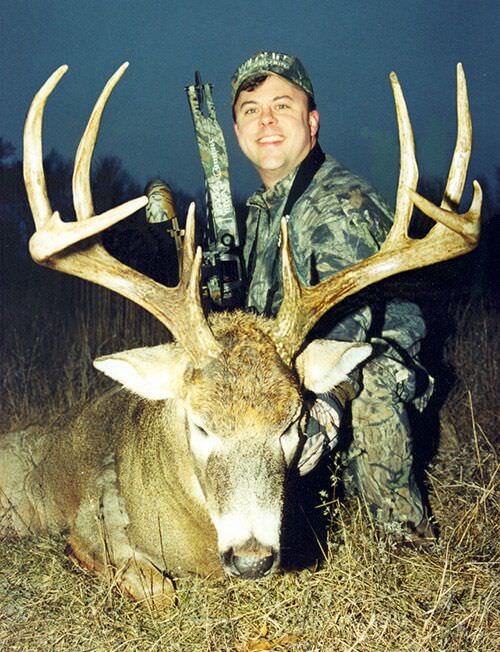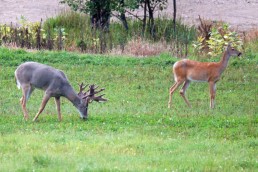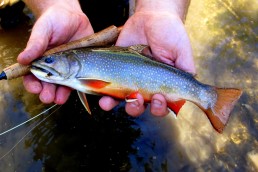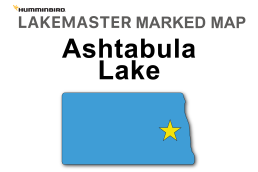Make a Food Plot Plan: Antlers or Attraction?
SHARE THIS POST
What should I plant?
This is by far the most-asked question regarding food plots for whitetails. A fair bit of understanding is required to answer that query properly, but an easy way to view it is: Should you plant for nutrition and antler growth, or strive to attract and hold? Or, Do you have enough acreage to devote so you can do it all?
These questions really need to be answered based upon the management goals of the property owner, as well as if you want to enhance the health of your whitetail herd—maybe help to grow big antlers—or attract deer during the hunting season.
How you go about implementing a plan, including the plants that you choose to grow, can vary depending on the objective.
Which crops to select may depend on your existing conditions, the location of your property and how much available acreage you have to plant. For instance, you need to know if you’ve been experiencing a drought. Geographically, what you plant in Minnesota will often be different from what’s planted in Texas. In addition, small-acreage situations cannot support a multitude of goals—you have to be specific with your goals and your plantings.

Think about what your specific situation requires. Maybe you see mature bucks during the summer months, but they all seem to disappear when the season rolls around. If that’s the case, attraction during the hunting season may be your aim. On the other side of this puzzle, let’s say last season you harvested a 120-inch, 5×5 and had it aged only to find out it was a 5-year- old animal. Some of that could be due to genetics, but in this case my suggestion would be to plant to help antler growth and nutrition.
Property location and acreage have two main considerations: In agricultural areas where there is a lot of cash-crop farming, like corn, soybeans, or alfalfa, it may be wise to concentrate on attraction if this farming is already supplying a good portion of their diet. Likewise, if you only have a couple acres or less to devote to food plots, let’s face it—most managers want to use it for attraction during the hunting season.
What you plant in each plot should vary for each end goal. More than likely, the size, location, and design of your plots would also be different for attraction as opposed to nutrition. More often than not, the larger plots farther away from the bedding areas are designated as “feeding plots,” where the smaller plots closer to the bedding areas are used for “hunting plots.” It’s simply common sense at work here: Your chances for a shot during legal shooting hours are better when covering a smaller plot closer to their bedding area. Since your chances of killing deer farther away from the bedding area decreases exponentially, the farther away you get from bedding, the more likely the spot will be designated a “destination” feeding plot.
It is possible to do both, supply nutrition to help with overall health and antler growth, and have attraction in other areas to help with your harvest goals, viewing opportunities and holding them in the area. In fact, with every property that I oversee I will try to “do it all” if there is adequate available acreage. Granted, many folks are “handcuffed” by limited acreage, however, a versatile, all-around approach will typically show the biggest payout.
If your goal is attraction, you should attempt to have a nutritious, palatable food choice for your herd for the entire time frame you wish to draw. Actually, it should be suggested that you provide choices that will turn palatable and begin attracting before you want to hunt the location so that you get the animals conditioned to the site.
Are you enjoying this post?
You can be among the first to get the latest info on where to go, what to use and how to use it!
If your goal is nutrition, it is best to have a nutritious, palatable food choice for them all year long. Again, available acreage must be considered: Do you have enough ground to provide food all year long with your density? If not, it doesn’t mean you can’t strive toward antler growth and nutrition. It just means you have to make the best out of what you have and plant wisely.
Concerning antler growth, many managers feel that it is most important to have the best food source available for early stages of antler genesis during spring and summer. Although this is an important time, for a buck to really show you what he is capable of producing, good nutrition must be made available year ‘round. If, during the fall or winter their diet is lacking, when ample nutritious forage does become available in the spring and summer months, they end up playing “catch-up” rather than reaping the rewards. Most biologists agree, for a buck to really show you their maximum set of antlers they will need a “consistent food source of at least 16 percent protein.” In fact, I would argue that here in the North, if you want to see a noticeable difference in antler growth, late fall through the winter and into early spring is the most important time to bolster their nutrition.
Certain plants do a good job at both attraction and nutrition. Brassicas, clover, various beans and peas all do a good job at both attraction and nutrition. Timing and placement would by and large dictate how the cultivars are to be used.
Good examples of plants in a typical nutrition plot are red and white clovers, chicory, alfalfa, lablab, soybeans and cowpeas.
Ideal cool-season choices are brassicas like rapa, radishes, kale and turnips, which give both great energy and protein. Corn, sorghum, and milo are not good protein sources, but they will provide needed carbohydrates (for energy) and fat. Whitetails are good at breaking down proteins and turning it into energy, so many of the same warm-season choices will remain beneficial most of the year.
As mentioned, many of the same plants work well for attraction; timing is everything. Certain annual plants like cereal grains and annual legumes are the most palatable during certain stages of growth. So you want to time the planting so it reaches its peak of attraction when you want to use it for a draw. Good early-season choices are perennials like clovers, alfalfa and chicory, then switch over to midseason draws like oats, wheat, triticale, rye and certain brassicas like radishes.
Late season and into winter, one of the most important considerations is accessibility to food. If the food is covered by 3 feet of ice and snow it really doesn’t matter; brassicas, corn and dried soybeans are wintertime staples.
Regardless of your goals, variety is key. During the year, weather and temperatures are changing, plants are changing and the whitetails’ needs are too. You want to make sure that you have a food to supply them regardless of the conditions or time of year. You can put equal emphasis on both attraction and nutrition. A good management program probably will stress the importance of both good nutrition to help grow big, healthy whitetails and attraction to help with animal sightings and harvest goals.
Food plots not only help to grow healthy big-antlered bucks, but they also make harvesting them much easier too. Here, Todd Amenrud poses with a buck attracted to brassicas.
MWO
SHARE THIS POST
Did you enjoy this post?
You can be among the first to get the latest info on where to go, what to use and how to use it!
Todd Amenrud
Todd Amenrud is a full time sportsman whose passion is bowhunting whitetails. He spends considerable time researching whitetails, and has written six books on the subject. Harvesting 47 record-book animals and his ability to share his knowledge have made him one of the Midwest’s most-recognized hunting resources.





Thanks for going over some ideas for food plots. I actually wasn’t aware that to have a good nutritious plan you need to have a palatable food choice all year. I’m kind of interested to learn more about these types of plants that you can use to achieve this, especially if it could differ depending on where you live.
Sorry for this late response, but you are welcome. We appreciate your comment and hope the story helps you grow some big deer!
Dave Mull
Digital Editor
Taylor,
I’ve very sorry this reply is so late. When I originally tried to reply, the link was invalid and I couldn’t respond.
We don’t necessarily “need” year-around food source for our deer, a whitetail can survive on native vegetation, if there is enough. However, most biologists agree that for a buck to produce his best set of antlers and be at the top of his health and for a doe to consistently churn out healthy fawns, a whitetail will need a consistent diet of at least 16% protein.
On average, an acre of native vegetation will produce about 200 to 300 pounds of “deer food” (browse, mast, forbs, etc) annually at approximately 7% to 10% protein. However, if they actually consumed that much you would see a browse line about 6 feet high and the habitat would be destroyed. So they can only actually use about 80 to 100 pounds per acre without destroying the area.
On average an adult deer will consume about six pounds of feed per day. Multiplied by 365 days per year and you get 2,190 pounds of feed per year. So, one deer can be supported on roughly 22 acres. However, body size, health and antler size are going to be well under their potential because of the poor average protein content of the native vegetation.
There are some that would argue that feeding corn or protein pellets makes everything alright. Corn, has approximately 8% protein, so even native vegetation is better than corn. The carbohydrates that corn produces does have a place, but even if you are feeding protein pellets at around 20% protein, you still have to consider predation, disease transmission, legality, aesthetics, the amount consumed by non-target animals and the cost.
I’m not saying that supplemental feeding is bad – on the contrary, I believe supplemental feeding is a good thing pending you do it right. But even if you do everything correct it is shown that no matter what you feed or how you feed it, deer will only consume 20% to 25% of their diet from the supplemental feed! So you are not significantly increasing your property’s carrying capacity and you are not making a big impact on their nutritional intake either. You are still well below the 16% biologists say is necessary.
There is no way that you can supply the amount or the quality of food that you can for the cost, then by planting food plots. Food plots are going to decrease the average home range size for each deer in the area and in doing so can significantly increase your property’s carrying capacity! Food plots are going to supply well above the necessary 16% protein so your deer will have a chance to express their true health and antler growing potential. Remember we said that they will only consume 20% to 25% of their diet in supplemental feed. It is shown that they will consume approximately 75% to 85% of their diet in food plot crops! It is probably for two reasons; one, because it is more like browsing to them. Deer are naturally browsers. It is unnatural for them to stand at a feeder. Two, because of the quality of the forage – food plots produce forage that is much more palatable and digestible than corn, protein pellets or native vegetation.
If you have any other questions, please feel free to email me at tamenrud@mossyoak.com
Thanks!!!